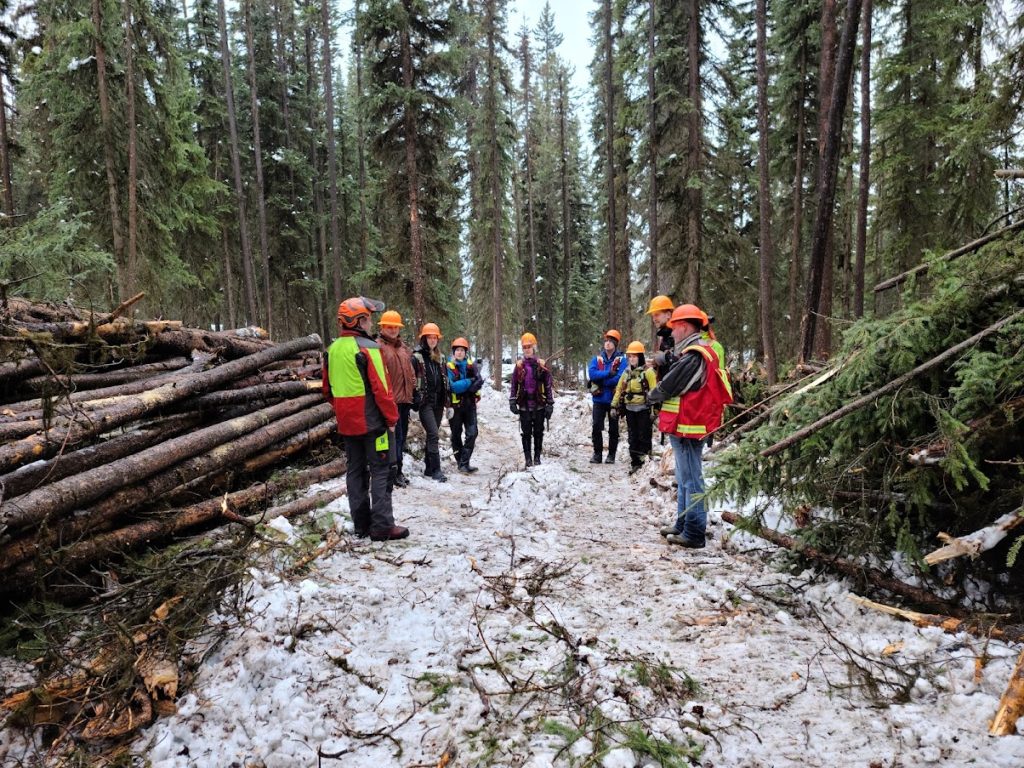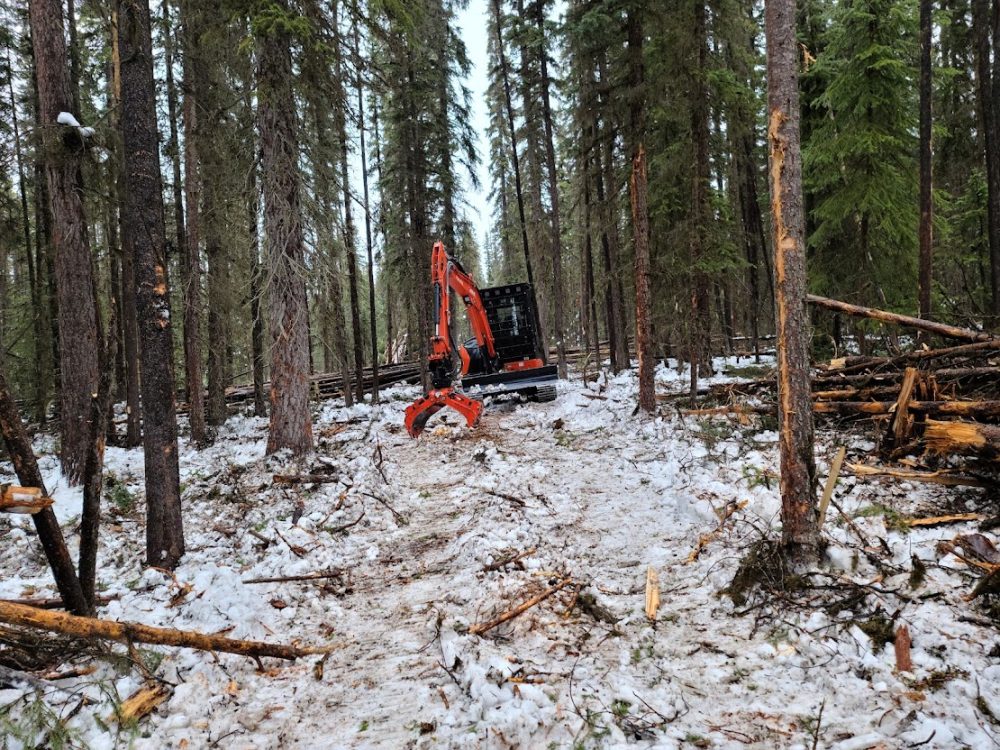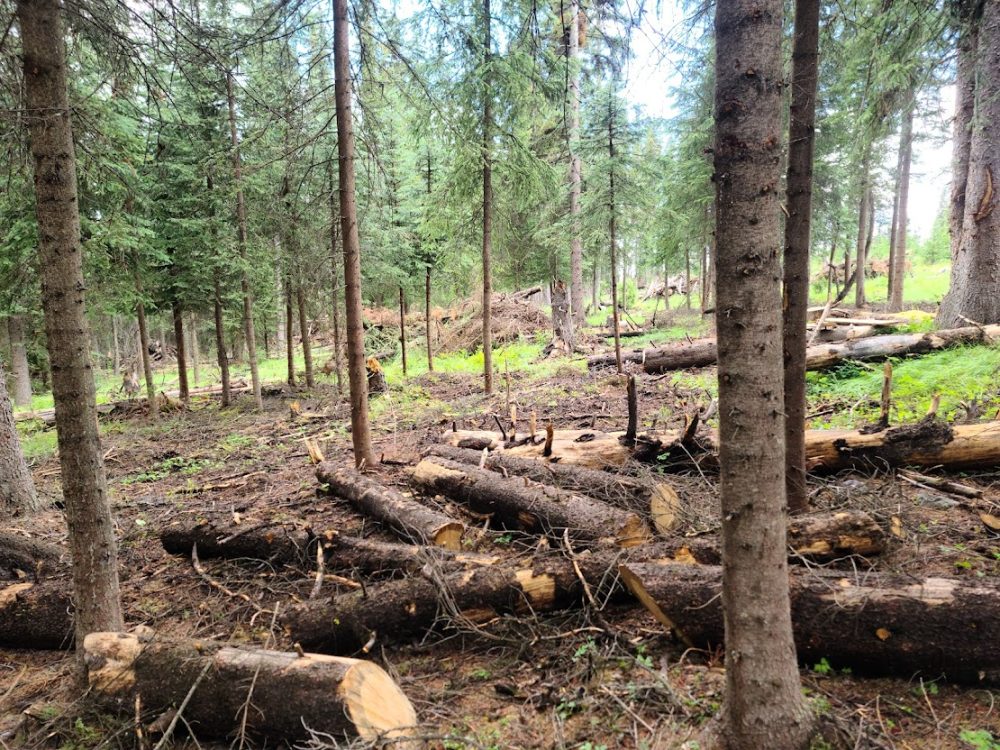
Features
Forestry Management
Harvesting
B.C. community forest continues to reduce wildfire risk to the communities
October 25, 2022 By Forest Enhancement Society of BC
 Face-Paska site visit with Ministry of Forests and LLCF. Left to right: Burke Nesjan (Skeetchestn NRC’s Contractor), Garnet Mierau (LLCF), Hailey Sigalet (LLCF), Julie Maxwell (FOR), Aaren Ritchie-Bonar (FOR), Nolan Buis (FOR), Nicola McGrath (FOR), Ben Humphrey (FOR), Norman Berg (BC Wildfire Service). Photo: FESBC.
Face-Paska site visit with Ministry of Forests and LLCF. Left to right: Burke Nesjan (Skeetchestn NRC’s Contractor), Garnet Mierau (LLCF), Hailey Sigalet (LLCF), Julie Maxwell (FOR), Aaren Ritchie-Bonar (FOR), Nolan Buis (FOR), Nicola McGrath (FOR), Ben Humphrey (FOR), Norman Berg (BC Wildfire Service). Photo: FESBC. When Logan Lake became the first FireSmart community in B.C. in 2013 – a result of efforts starting back in the early 2000s – the community was preparing for any potential wildfires, through their wildfire risk reduction projects. Furthermore, the Tremont Creek Wildfire in August 2021 actually proved that the 18-year-long undertaking by the District of Logan Lake, the Logan Lake Community Forest (LLCF), and the residents of the town, to prepare for the wildfire event in advance, was effective and turned out to be a significant factor in saving the community.
This outcome has spurred the LLCF, in collaboration with the communities of Logan Lake and the Face-Paska Lakes area, into further action to step up the wildfire mitigation efforts through Forest Enhancement Society of BC (FESBC) funding.
“The Forest Enhancement Society of BC is a proven partner in delivering projects on the ground that protect people from wildfire risks and reduce emissions from slash pile burning,” said Katrine Conroy, Minister of Forests. “Along with the historic investments in Budget 2022 to transform the BC Wildfire Service into a year-round service and double funding for proactive wildfire prevention, the critical work of FESBC is helping build communities that are safer and more resilient to climate change.”
“The area was identified in the Logan Lake Community Forest Wildfire Risk Management Plan (WRMP) as requiring attention and action, for which LLCF received $512,000 in follow-up funding from FESBC. The treatments will help reduce wildfire hazards through fuel reduction in areas directly adjacent to residential developments,” said Randy Spyksma, a planner with Forsite, manager of the Logan Lake Community Forest and board member with the BC Community Forest Association.

Equipment operating at Face-Paska. Photo: FESBC.
“This fuel work, being completed by Skeetchestn Natural Resources Corp., has the crews removing dead and downed woody debris in the area which can pose a significant wildfire threat to the community. Recently, FESBC has also funded the development of a fuel management prescription in order to improve the resiliency of the main evacuation route, further investing in risk reduction efforts to help make these areas safer for people!” added Spyksma.
The priority fuel treatment work around the Face/Paska community is nearing completion and the fibre that couldn’t be utilized is being made available for firewood for the local community members. The planning work is now starting in order to reduce the wildfire risk along the evacuation route from the communities.
“FESBC’s support for fuel management treatments in the resort areas of Face and Paska Lakes will be key to reducing wildfire risks in this area,” said Garnet Mierau, RPF, planner with Forsite, part of the LLCF management team and the 75th council president for the Association of BC Forest Professionals.
Beyond timber and wildfire risk reduction, the projects undertaken by LLCF have been a good example of community engagement and collaborative work. From the completion of the original WRMP and development of fuel management prescriptions to the implementation of the work, LLCF has engaged Indigenous communities, local groups, and the general public to ensure interests are balanced and there is a collaborative approach overall.
“Mile High Resort was invited to be a part of the original wildfire planning work and is appreciative of the community forest, funding from FESBC, and the support of BC Wildfire Service in the Face/Paska area. We now look forward to ongoing collaboration and actions to support wildfire resilience for the community,” said Bob van Tongeren, owner-operator of Mile High Resort and Logan Lake Community Forest Corporation board member.

Face-Paska post-treatment. Photo: FESBC.
The work with van Tongeren is just one example of the collaborative efforts that have taken place as a part of work undertaken by the community forest.
“The scale of our engagement of the efforts was unique to British Columbia when we started work on the original strategic landscape-level WRMP followed by a fuel management program,” noted Mierau, “The engagement helped to proactively support a range of wildfire risk reduction activities.”
The community forest has also been instrumental in engaging with the education sector to support awareness and collaboration regarding the activities of the community forest in general, and specific to wildfire risk reduction. Over the years, LLCF has collaborated with Thompson Rivers University, the BC Institute of Technology, the University of British Columbia (UBC) Tree Ring Lab, and the local high school in Logan Lake. This approach supports collaboration to better understand wildfire risk and how to design and maintain risk mitigation.
“We are collaborating with academic organizations and investing in students, who are the future of forest management in community forests and across the province,” said Mierau.
LLCF is one of the 10 community forests with whom UBC has been collaborating to measure the efficacy of treatments that aim to mitigate hazardous fuels and reduce wildfire risk, confirmed professor, Dr. Lori D. Daniels.
“LLCF has demonstrated great initiative to connect with the local public and education through collaboration with other community forests and with us at UBC. Involving youth through paid summer positions is a great way to provide local job opportunities while mitigating fuels and generating a grassroots connection for public education. Leadership with the LLCF has engaged with multiple research projects at UBC, allowing us to document the barriers communities face when attempting to address wildfire risk and solutions for overcoming those barriers, which have now been shared with other Community Forests, municipalities, and First Nations communities throughout B.C.,” said Dr. Daniels. “We are grateful for the opportunity to collaborate with them!”
The LLCF recently applied to the FESBC 2022-23 Funding Program and has received funding for three new projects. “There is definitely follow-up involved in these wildfire risk reduction activities; it is not a one-and-done deal and so, we will continue our work in reducing the risk of wildfires to our communities,” Mierau said. “It is great to have re-occurring funding, as we have thankfully experienced with FESBC, to support our work.”
The three projects which LLCF will be undertaking through the FESBC funding are:
- a project to develop prescriptions and treat areas near Logan Lake, creating a large landscape-level fuel break,
- a project to complete the planning and preparation required to complete treatments along a corridor along the Coquihalla Highway to reduce the risk of human-caused ignitions from the highway, and
- a project to finish the planning work required to complete a fuel-reduction treatment to support safer evacuation for the community at Face and Paska Lakes.
“FESBC has supported the Logan Lake Community Forest and the communities at Face, Paska, and Logan Lake since the beginning of our work, from supporting innovative and collaborative wildfire risk management planning work to the implementation of priority prescriptions and treatments. This new round of funding demonstrates that continued support,” said Spyksma.
Print this page